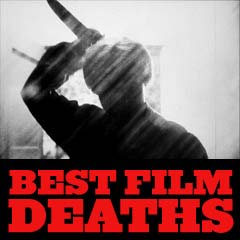
|
Deaths Scenes 1958-1959 |

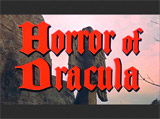
|
Horror of Dracula (1958, UK) (aka Dracula) Director Terence Fisher's classic Technicolored Dracula horror film was the first of the UK's Hammer Studios' horror films about Dracula for the next two decades - a superb, Gothic, blood-drenched tale of the cat-and-mouse game between Count Dracula (Christopher Lee) and his arch nemesis Dr. Van Helsing (Peter Cushing), a formidable vampire hunter. In the film's gripping and memorable finale, the two were engaged in a battle between the forces of Darkness and Light - between Van Helsing and Dracula who fought throughout Dracula's castle. Van Helsing was able to weaken Dracula by running across two table-tops, leaping into the air and ripping down full-length curtains to let in sunlight - and then crossing two candlesticks into the shape of a crucifix to force Dracula backwards. Dracula began to expire and disintegrate in the rays of the sun (mostly off-camera) - and the film concluded with his ashes blowing away in the wind. |
   
|

|
I Want to Live! (1958) The dramatic film concluded with a realistic San Quentin gas-chamber execution scene. Prostitute, drug-addict, and convicted murderer Barbara Graham (Susan Hayward) was advised: "When you hear the pellets drop, count ten, take a deep breath - it's easier that way." She responded: "How do you know?", and then clenched her fist and slumped over in death. The film helped to serve as an argument against capital punishment. |
  Gas Chamber Execution |

|
The Left Handed Gun (1958) In director Arthur Penn's debut feature film, legendary outlaw Billy the Kid (aka William Bonney) (Paul Newman) was an anguished, misfit, unstable, simple-minded, and suicidal juvenile delinquent - a James Dean-like anti-hero character. The western had a long tagline:
In this modern American film, he was confronted at gunpoint by lawman Pat Garrett (John Dehner), who kept asking: "Billy, come to me." When Billy turned (in an attempt to provoke the lawman to end his life), Garrett thought that he was reaching for his gun, and shot him to death. As Billy expired, he held out his left hand (although in real-life, he was probably right-handed) to show that he was unarmed and had an empty gun holster, then staggered forward and collapsed onto the ground. Afterwards, Garrett commented to Billy's married love interest, peasant Celsa (Lita Milan) about how he was blameless for shooting an unarmed man: "He went for an empty holster. I couldn't see." She responded with the film's last line: "You come home now." |
    Billy the Kid's Unarmed Death |

|
Obese Texas cop Hank Quinlan (Orson Welles) shot his own long-time police partner Pete Menzies (Joseph Calleia), using Mexican police detective Mike Vargas' (Charlton Heston) own gun to frame him. Quinlan expected to frame Vargas and blame him for Menzies' death. As Menzies was lying on the bridge above, still alive but mortally wounded, Quinlan turned his gun on Vargas, and threatened to kill him for resisting arrest. Before Quinlan could fire, Menzies shot his partner and then slumped dead. The DA's assistant Schwartz (Mort Mills) arrived with Vargas' wife Susan (Janet Leigh) in a car and rushed to the scene. Vargas ran to his wife and hugged her in their car. Schwartz played back the tape recording of their conversation. As Quinlan expired and listened to his own confession (of how he was "aiding justice" by planting evidence to frame what he claimed were "guilty" individuals throughout his career), a close-up of his sweating, contorted face appeared. Vargas promised his wife: "It's all over, Susie. I'm taking you home. Home." Cleared of the drug charge, they sped away to a safer, more secure place. Wise mystical fortune-teller Tanya (Marlene Dietrich) ran across the bridge toward Quinlan, as the tape continued to play his confession. At the tape's climax, Quinlan stood up, and heard the gun shot on the tape. He looked up at the dead body of Menzies (dripping blood) on the bridge above and mumbled to his treasonous partner who betrayed him: "Pete. That's the second bullet I, I stopped for you." When Quinlan lost his balance, his large, flailing body fell backwards into the oily, dark water. As he floundered and died like an animal in the shallow canal, Tanya was left to watch Quinlan's body floating in the muddy water. When Tanya was asked if she had anything more to say about "lousy cop" Quinlan, she eulogized Quinlan as she looked wryly at his body lying and floating away in the dirty water - providing a famous epitaph (above the sound of pianola music):
|
   Quinlan Threatening Vargas  A Dying Menzies Firing and Mortally Wounding Quinlan  "Pete. That's the second bullet I, I stopped for you."  Obese Texas Cop Falling Backwards and Dying in Dirty, Muddy Water |

|
Hitchcock's suspense thriller ended with the emotionally-shattering death scene of Judy Barton's/Madeleine's (Kim Novak) 'second' (and fatal) fall from the church belltower. Judy was anguished as she pleaded for forgiveness from detective Scottie Ferguson (James Stewart), explaining how she willingly endangered herself by getting emotionally involved with him after the murder. With great sincerity and commitment, she professed that she still loved him even though he was her victim. Experiencing intense feelings of both repulsion (hate) and attraction (love), he softened when she insisted that she loved him and fell into his arms for a passionate embrace and kiss - they renewed their twisted love. Then, suddenly the footsteps of a black-clad figure in the shadows startled Judy. She backed away from Scottie gasping: "Oh, no!" The dark, shadowy figure said: "I hear voices." Terrified, thinking and believing she was seeing the ghost of the murdered Madeleine (or the reincarnation of the ghostly doomed mother Carlotta Valdes), Judy recoiled, stepped and fell backwards through an opening in the tower and plummeted to her own death (off-screen) in an emotionally-shattering climax. The figure, actually a nun from the mission, crossed herself and murmured the last words of the film: "God have mercy." The nun (a Mother Superior or virginal Sister of Mary?) pulled the bell rope and rang the mission bell. As the bell tolled (signaling not salvation but eternal damnation), Scottie emerged from the arched window of the tower onto the belfry ledge. He stared down in horror at her body far below - stunned, open-mouthed, shocked and glassy-eyed with his arms slightly away from his body. He was cured of his vertigo, but totally destroyed by his other delusions and burgeoning sorrow. Would he join her in a suicidal leap, or again go mad? Tragically loving and losing the same woman twice, repeating the pattern he had intended to break, the scene faded to black. |
  "God have mercy."   Second Fatal Fall From Church Belltower |
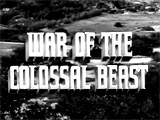
|
War of the Colossal Beast (1958) In this B-film science-fiction sequel directed by Bert Gordon, giant 70-foot man Lt. Col. Glenn Manning (Dean Parkin) died after already suffering horrible disfiguration (missing an eye) and scarring from his fall off Boulder Dam in the prior film The Amazing Colossal Man (1957). Now, the Colossal Beast committed suicide by electrocuting himself on electrical power lines near Griffith Park Observatory in Los Angeles. [Note: The death was most memorable for being a gimmicky color sequence that suddenly appeared at the end of the B/W film.] |
 Electrocution for the "Colossal Beast" |
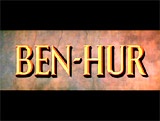
|
After being trampled and mortally wounded, defeated and mangled Roman charioteer Messala (Stephen Boyd) ("the smashed body of a wretched animal") perished in an excruciatingly painful death scene after the thrilling chariot race against Judah Ben-Hur (Charlton Heston). He had enough vengeful breath to tell his victorious opponent:
|
 "The race is not over." |
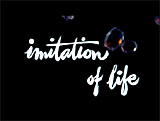
|
Imitation of Life (1959) Self-sacrificing, widowed, and gravely ill black housekeeper Annie Johnson (Juanita Moore) died of a broken heart on her deathbed. There was a moving concluding scene at her funeral (with gospel star Mahalia Jackson singing "Trouble of the World") when her remorseful light-skinned daughter Sarah Jane (Susan Kohner) mourned at her casket and begged for forgiveness: "Mama, Mama, I didn't mean it, I didn't mean it. Mama, do you hear me? I'm so sorry, I'm sorry, Mama. Mama, I did love you...I killed my mother, I killed her. I wanted to come home. Now she'll never know how much I wanted to come home." |
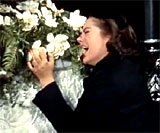 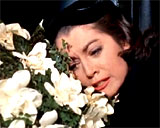 Remorseful for Mother's Death |

|
In one of many classic scenes or images in the film, this time at the UN building in NYC, as businessman Roger Thornhill (Cary Grant) showed Lester Townsend (Philip Ober) a photograph of the other 'Lester Townsend,' the real Townsend gasped and fell forward into Roger's arms. A knife had been thrown by one of the thugs but it failed to hit its intended target - it was a second assassination attempt on Kaplan's life. After pulling the knife out of Townsend's back, Roger was photographed holding the knife in mid-air ("He's got a knife, look out!"). Roger blurted out: "Listen to me. I had nothing to do with this." But it appeared to the crowd that Roger had killed the UN diplomat, and he fled from the scene in a panic, after dropping the knife and rushing out of the hall. He was again a victim of mistaken identity - but this time implicated as an assassin and murderer. Thornhill must now hide from both the pursuing police and enemy agents. Realizing his dilemma, he ran outside onto a long sidewalk and got into an awaiting cab (filmed from high above the UN, making him look like a tiny object being examined under a microscope). |
  Wrongly Accused of Murder 
|
(chronological by film title) Intro | 1915-1929 | 1930-1933 | 1934-1938 | 1939 | 1940-1942 | 1943-1945 | 1946-1947 | 1948-1949 1950-1952 | 1953-1955 | 1956-1957 | 1958-1959 1960-1961 | 1962-1963 | 1964-1966 | 1967-1968 | 1969-1970 1971 | 1972 | 1973 | 1974 | 1975 | 1976 | 1977-1978 | 1979 1980 | 1981 | 1982 | 1983 | 1984 | 1985 | 1986 | 1987 | 1987 | 1988 | 1989 1990 | 1991 | 1992 | 1993 | 1994 | 1994 | 1995 | 1995 | 1996 | 1997 | 1998 | 1998 | 1999 2000-2001 | 2002 | 2003 | 2004 | 2005 | 2006 | 2007 | 2008 | 2009 | 2010 | 2011 |